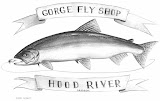 |
| Airflo Rage Compact |
Think of this line as a cross between a Scandi line and a Skagit line that is meant for dry line fishing and light sink tip work. It is slightly shorter than most Scandi lines, but fishes very similarly. It is longer than Skagit heads, but casts very similarly. More mass in the back and front end of the line taper allow it to turn over better than Scandi lines in windy conditions.
Why Rage?
1. Dry Line Presentation in Windy Conditions
If you are bummed about the way your Scandi handles in the breeze – which is a very common frustration – try the Rage. By keeping grain weight more compact over a shorter distance of line and adding a slightly more aggressive front taper, this line slices through wind.
2. Tight Casting Quarters.
You can make smaller D-Loops with this line. Much like the Airflo Skagit Compact, the Rage is tapered to load under a smaller stroke. The beauty lay in having the ability to put your back up against a grassy bank, or up under over-hanging tree branches and shooting dry-line presentations with little effort.
3. The Skagit/Scandi Dilemma
For those who spend a lot of time casting sink tips with Skagit lines, the move to Scandi lines can be pretty frustrating – as can the vice versa scenario. The stroke is different. Skagit lines are built to be cast with a more compact stroke, where Scandi lines demand a slightly more open stroke with a little more finesse. If you want to spend less time relearning how to cast every time you switch out from a Skagit, try the Rage.
4. Sink-Tip Ability with Floating Line
So the sun is up and the fish have lost that aggressive edge? Drop it down with a tip. Without switching to a Skagit, just loop on a sinking polyleader or modest amounts of level Tungsten tip (up to modest amounts of T-11 or Type 6). I should say that Scandi lines can handle dense polyleaders/versileaders, but level T-Tips above T-8 are pretty debilitating. With more condensed mass, the Rage Head can handle heavier tips than Scandi Heads (Unless of course, you are using the Scandi Short Versitip)… If you really need to get deep however, the Skagit is where it’s at.
Over the years my affinity for shorter spey heads - for both sink-tip and dry line fishing – has grown considerably. I am sold on the pure comfort involved with using shorter strokes and trying to manage less amounts of line during the cast. I like both Scandi Lines and these innovative Rage lines for this very reason. However, if the circumstances above apply to you, I recommend the Rage.
If you fish a Skagit, choose a Rage Line that is right around 30 grains less than your Skagit line grain weight. Much like Scandi’s, the Rage is designed to be fished using a polyleader. A ten foot polyleader is most popular among anglers but those using long rods or those who have an aggressive stroke may prefer a 14 foot poly. Conversely, those using shorter switch rods or those who prefer a very relaxed stroke, may find the 5 foot polyleader to work best.
Airflo Rage Spey Head
Have a good time,
Duffy
























Thanks for the great review Duffy! As I've gotten to know this line over the past season, I've found that advanced casters often like lighter loads than 30 grains less than their Skagit. If you want your line to feel more like a Scandi -and like to use a very bottom hand dominant casting stroke, go 60 to 90 grains lighter than your Skagit. However, If you're new to casting or just like a more Skagit-like feel with your line, stick with the 30 grains less rule.
ReplyDelete-Tom Larimer
This stuff is getting too complicated!~ Is it just me, or should I be thrilled that there are so many choices!? I mean the old timers over on the Drowes in Donegal all fished with one line period. My two cents. Great review nonetheless!
ReplyDeletePD
Tom, much thanks for the added insight! This is good stuff and I certainly should have taken this into account as far as sizing goes
ReplyDeletePd - thanks for your comments.. Now doubt! I hear you. but innovation never sleeps amigo. Tom will not allow it